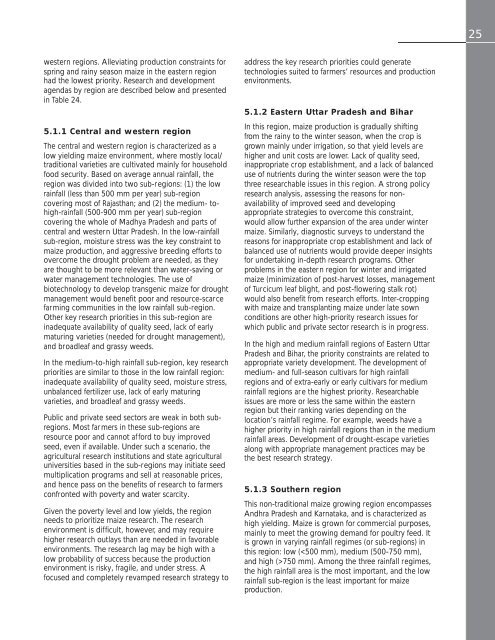Maize in India: Production Systems, Constraints - AgEcon Search
Maize in India: Production Systems, Constraints - AgEcon Search
Maize in India: Production Systems, Constraints - AgEcon Search
Create successful ePaper yourself
Turn your PDF publications into a flip-book with our unique Google optimized e-Paper software.
25<br />
western regions. Alleviat<strong>in</strong>g production constra<strong>in</strong>ts for<br />
spr<strong>in</strong>g and ra<strong>in</strong>y season maize <strong>in</strong> the eastern region<br />
had the lowest priority. Research and development<br />
agendas by region are described below and presented<br />
<strong>in</strong> Table 24.<br />
5.1.1 Central and western region<br />
The central and western region is characterized as a<br />
low yield<strong>in</strong>g maize environment, where mostly local/<br />
traditional varieties are cultivated ma<strong>in</strong>ly for household<br />
food security. Based on average annual ra<strong>in</strong>fall, the<br />
region was divided <strong>in</strong>to two sub-regions: (1) the low<br />
ra<strong>in</strong>fall (less than 500 mm per year) sub-region<br />
cover<strong>in</strong>g most of Rajasthan; and (2) the medium- tohigh-ra<strong>in</strong>fall<br />
(500-900 mm per year) sub-region<br />
cover<strong>in</strong>g the whole of Madhya Pradesh and parts of<br />
central and western Uttar Pradesh. In the low-ra<strong>in</strong>fall<br />
sub-region, moisture stress was the key constra<strong>in</strong>t to<br />
maize production, and aggressive breed<strong>in</strong>g efforts to<br />
overcome the drought problem are needed, as they<br />
are thought to be more relevant than water-sav<strong>in</strong>g or<br />
water management technologies. The use of<br />
biotechnology to develop transgenic maize for drought<br />
management would benefit poor and resource-scarce<br />
farm<strong>in</strong>g communities <strong>in</strong> the low ra<strong>in</strong>fall sub-region.<br />
Other key research priorities <strong>in</strong> this sub-region are<br />
<strong>in</strong>adequate availability of quality seed, lack of early<br />
matur<strong>in</strong>g varieties (needed for drought management),<br />
and broadleaf and grassy weeds.<br />
In the medium-to-high ra<strong>in</strong>fall sub-region, key research<br />
priorities are similar to those <strong>in</strong> the low ra<strong>in</strong>fall region:<br />
<strong>in</strong>adequate availability of quality seed, moisture stress,<br />
unbalanced fertilizer use, lack of early matur<strong>in</strong>g<br />
varieties, and broadleaf and grassy weeds.<br />
Public and private seed sectors are weak <strong>in</strong> both subregions.<br />
Most farmers <strong>in</strong> these sub-regions are<br />
resource poor and cannot afford to buy improved<br />
seed, even if available. Under such a scenario, the<br />
agricultural research <strong>in</strong>stitutions and state agricultural<br />
universities based <strong>in</strong> the sub-regions may <strong>in</strong>itiate seed<br />
multiplication programs and sell at reasonable prices,<br />
and hence pass on the benefits of research to farmers<br />
confronted with poverty and water scarcity.<br />
Given the poverty level and low yields, the region<br />
needs to prioritize maize research. The research<br />
environment is difficult, however, and may require<br />
higher research outlays than are needed <strong>in</strong> favorable<br />
environments. The research lag may be high with a<br />
low probability of success because the production<br />
environment is risky, fragile, and under stress. A<br />
focused and completely revamped research strategy to<br />
address the key research priorities could generate<br />
technologies suited to farmers’ resources and production<br />
environments.<br />
5.1.2 Eastern Uttar Pradesh and Bihar<br />
In this region, maize production is gradually shift<strong>in</strong>g<br />
from the ra<strong>in</strong>y to the w<strong>in</strong>ter season, when the crop is<br />
grown ma<strong>in</strong>ly under irrigation, so that yield levels are<br />
higher and unit costs are lower. Lack of quality seed,<br />
<strong>in</strong>appropriate crop establishment, and a lack of balanced<br />
use of nutrients dur<strong>in</strong>g the w<strong>in</strong>ter season were the top<br />
three researchable issues <strong>in</strong> this region. A strong policy<br />
research analysis, assess<strong>in</strong>g the reasons for nonavailability<br />
of improved seed and develop<strong>in</strong>g<br />
appropriate strategies to overcome this constra<strong>in</strong>t,<br />
would allow further expansion of the area under w<strong>in</strong>ter<br />
maize. Similarly, diagnostic surveys to understand the<br />
reasons for <strong>in</strong>appropriate crop establishment and lack of<br />
balanced use of nutrients would provide deeper <strong>in</strong>sights<br />
for undertak<strong>in</strong>g <strong>in</strong>-depth research programs. Other<br />
problems <strong>in</strong> the easter n region for w<strong>in</strong>ter and irrigated<br />
maize (m<strong>in</strong>imization of post-harvest losses, management<br />
of Turcicum leaf blight, and post-flower<strong>in</strong>g stalk rot)<br />
would also benefit from research efforts. Inter-cropp<strong>in</strong>g<br />
with maize and transplant<strong>in</strong>g maize under late sown<br />
conditions are other high-priority research issues for<br />
which public and private sector research is <strong>in</strong> progress.<br />
In the high and medium ra<strong>in</strong>fall regions of Eastern Uttar<br />
Pradesh and Bihar, the priority constra<strong>in</strong>ts are related to<br />
appropriate variety development. The development of<br />
medium- and full-season cultivars for high ra<strong>in</strong>fall<br />
regions and of extra-early or early cultivars for medium<br />
ra<strong>in</strong>fall regions are the highest priority. Researchable<br />
issues are more or less the same with<strong>in</strong> the eastern<br />
region but their rank<strong>in</strong>g varies depend<strong>in</strong>g on the<br />
location’s ra<strong>in</strong>fall regime. For example, weeds have a<br />
higher priority <strong>in</strong> high ra<strong>in</strong>fall regions than <strong>in</strong> the medium<br />
ra<strong>in</strong>fall areas. Development of drought-escape varieties<br />
along with appropriate management practices may be<br />
the best research strategy.<br />
5.1.3 Southern region<br />
This non-traditional maize grow<strong>in</strong>g region encompasses<br />
Andhra Pradesh and Karnataka, and is characterized as<br />
high yield<strong>in</strong>g. <strong>Maize</strong> is grown for commercial purposes,<br />
ma<strong>in</strong>ly to meet the grow<strong>in</strong>g demand for poultry feed. It<br />
is grown <strong>in</strong> vary<strong>in</strong>g ra<strong>in</strong>fall regimes (or sub-regions) <strong>in</strong><br />
this region: low (750 mm). Among the three ra<strong>in</strong>fall regimes,<br />
the high ra<strong>in</strong>fall area is the most important, and the low<br />
ra<strong>in</strong>fall sub-region is the least important for maize<br />
production.

















